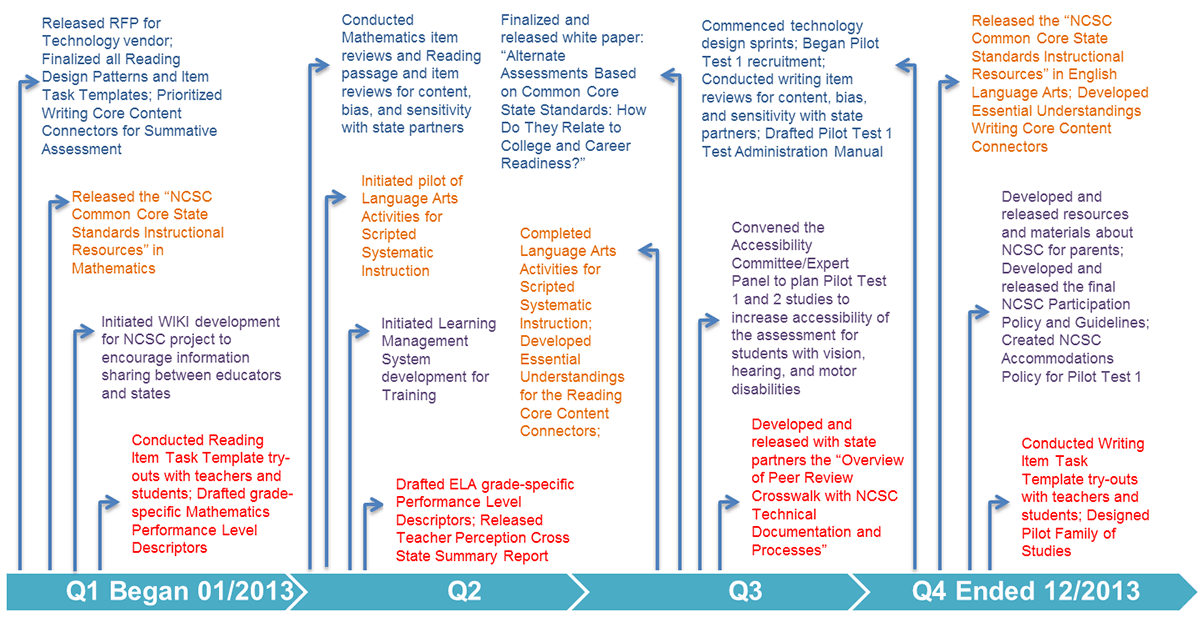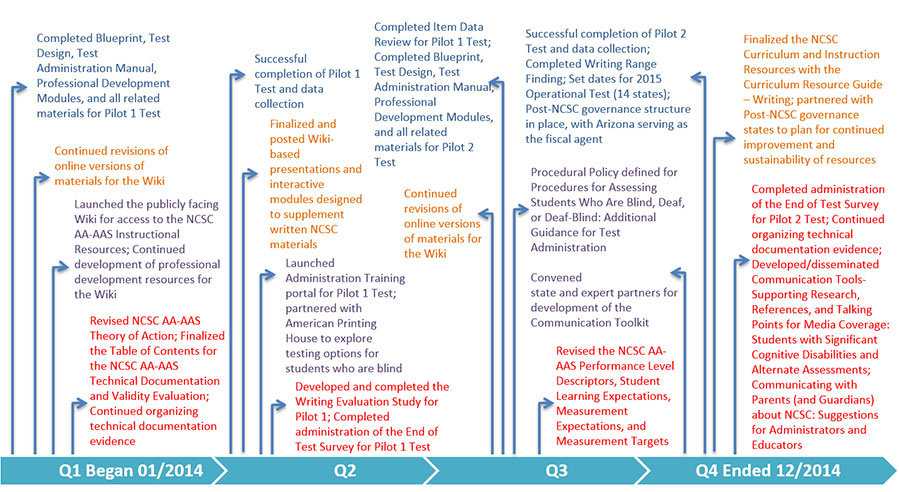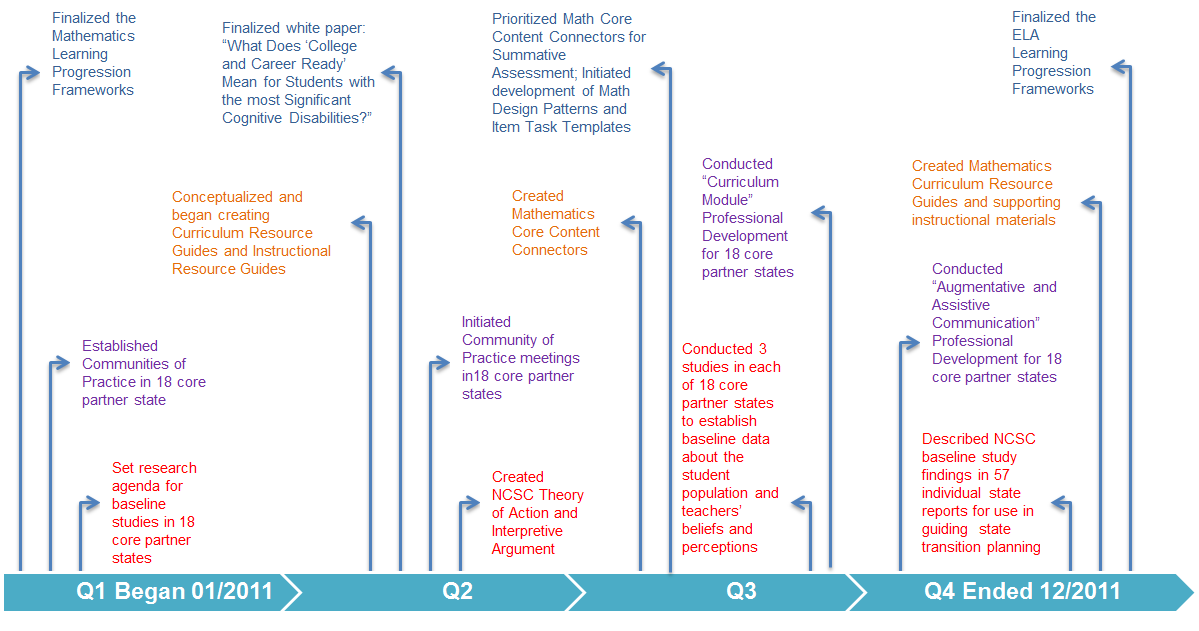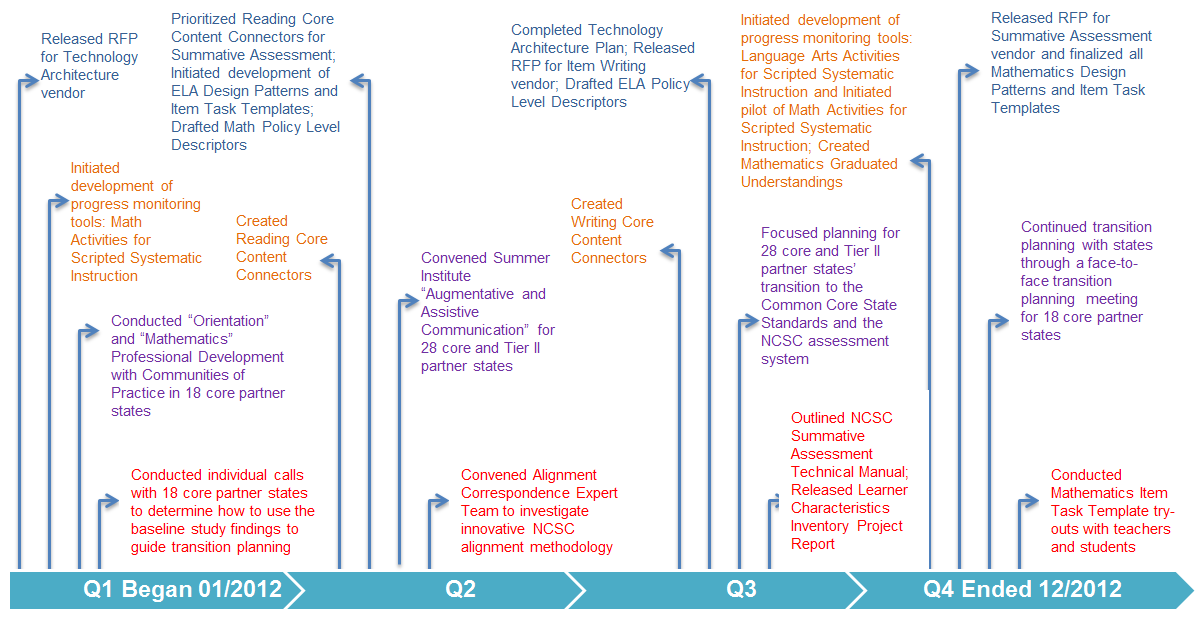Deliverables Years 1 - 4
- First Quarter 2011
- Finalized the Mathematics Learning Progression Frameworks
- Established Communities of Practice in 18 core partner state
- Set research agenda for baseline studies in 18 core partner states
- Second Quarter 2011
- Finalized white paper: “What Does ‘College and Career Ready’ Mean for Students with the most Significant Cognitive Disabilities?”
- Conceptualized and began creating Curriculum Resource Guides and Instructional Resource Guides
- Initiated Community of Practice meetings in18 core partner states
- Created NCSC Theory of Action and Interpretive Argument
- Third Quarter 2011
- Prioritized Math Core Content Connectors for Summative Assessment; Initiated development of Math Design Patterns and Item Task Templates
- Created Mathematics Core Content Connectors
- Conducted “Curriculum Module” Professional Development for 18 core partner states
- Conducted 3 studies in each of 18 core partner states to establish baseline data about the student population and teachers’ beliefs and perceptions
- Fourth Quarter 2011
- Finalized the ELA Learning Progression Frameworks
- Created Mathematics Curriculum Resource Guides and supporting instructional materials
- Conducted “Augmentative and Assistive Communication” Professional Development for 18 core partner states
- Described NCSC baseline study findings in 57 individual state reports for use in guiding state transition planning
- First Quarter 2012
- Released RFP for Technology Architecture vendor
- Initiated development of progress monitoring tools: Math Activities for Scripted Systematic Instruction
- Conducted “Orientation” and “Mathematics” Professional Development with Communities of Practice in 18 core partner states
- Conducted individual calls with 18 core partner states to determine how to use the baseline study findings to guide transition planning
- Second Quarter 2012
- Prioritized Reading Core Content Connectors for Summative Assessment; Initiated development of ELA Design Patterns and Item Task Templates; Drafted Math Policy Level Descriptors
- Created Reading Core Content Connectors
- Convened Summer Institute “Augmentative and Assistive Communication” for 28 core and Tier II partner states
- Convened Alignment Correspondence Expert Team to investigate innovative NCSC alignment methodology
- Third Quarter 2012
- Completed Technology Architecture Plan; Released RFP for Item Writing vendor; Drafted ELA Policy Level Descriptors
- Created Writing Core Content Connectors
- Focused planning for 28 core and Tier II partner states’ transition to the Common Core State Standards and the NCSC assessment system
- Outlined NCSC Summative Assessment Technical Manual; Released Learner Characteristics Inventory Project Report
- Fourth Quarter 2012
- Released RFP for Summative Assessment vendor and finalized all Mathematics Design Patterns and Item Task Templates
- Initiated development of progress monitoring tools: Language Arts Activities for Scripted Systematic Instruction and Initiated pilot of Math Activities for Scripted Systematic Instruction; Created Mathematics Graduated Understandings
- Continued transition planning with states through a face-to-face transition planning meeting for 18 core partner states
- Conducted Mathematics Item Task Template try-outs with teachers and students

- First Quarter 2013
- Released RFP for Technology vendor; Finalized all Reading Design Patterns and Item Task Templates; Prioritized Writing Core Content Connectors for Summative Assessment
- Released the “NCSC Common Core State Standards Instructional Resources” in Mathematics
- Initiated WIKI development for NCSC project to encourage information sharing between educators and states
- Conducted Reading Item Task Template try-outs with teachers and students; Drafted grade-specific Mathematics Performance Level Descriptors
- Second Quarter 2013
- Conducted Mathematics item reviews and Reading passage and item reviews for content, bias, and sensitivity with state partners
- Initiated pilot of Language Arts Activities for Scripted Systematic Instruction
- Initiated Learning Management System development for Training
- Drafted ELA grade-specific Performance Level Descriptors; Released Teacher Perception Cross State Summary Report
- Third Quarter 2013
- Finalized and released white paper: “Alternate Assessments Based on Common Core State Standards: How Do They Relate to College and Career Readiness?”
- Completed Language Arts Activities for Scripted Systematic Instruction; Developed Essential Understandings for the Reading Core Content Connectors
- Convened the Accessibility Committee/Expert Panel to plan Pilot Test 1 and 2 studies to increase accessibility of the assessment for students with vision, hearing, and motor disabilities
- Developed and released with state partners the “Overview of Peer Review Crosswalk with NCSC Technical Documentation and Processes”
- Fourth Quarter 2013
- Commenced technology design sprints; Began Pilot Test 1 recruitment; Conducted writing item reviews for content, bias, and sensitivity with state partners; Drafted Pilot Test 1 Test Administration Manual
- Released the “NCSC Common Core State Standards Instructional Resources” in English Language Arts; Developed Essential Understandings Writing Core Content Connectors
- Developed and released resources and materials about NCSC for parents; Developed and released the final NCSC Participation Policy and Guidelines; Created NCSC Accommodations Policy for Pilot Test 1
- Conducted Writing Item Task Template try-outs with teachers and students; Designed Pilot Family of Studies

- First Quarter 2014
- Completed Blueprint, Test Design, Test Administration Manual, Professional Development Modules, and all related materials for Pilot 1 Test
- Continued revisions of online versions of materials for the Wiki
- Launched the publicly facing Wiki for access to the NCSC AA-AAS Instructional Resources; Continued development of professional development resources for the Wiki
- Revised NCSC AA-AAS Theory of Action; Finalized the Table of Contents for the NCSC AA-AAS Technical Documentation and Validity Evaluation; Continued organizing technical documentation evidence
- Second Quarter 2014
- Successful completion of Pilot 1 Test and data collection
- Finalized and posted Wiki-based presentations and interactive modules designed to supplement written NCSC materials
- Launched Administration Training portal for Pilot 1 Test; partnered with American Printing House to explore testing options for students who are blind
- Developed and completed the Writing Evaluation Study for Pilot 1; Completed administration of the End of Test Survey for Pilot 1 Test
- Third Quarter 2014
- Completed Item Data Review for Pilot 1 Test; Completed Blueprint, Test Design, Test Administration Manual, Professional Development Modules, and all related materials for Pilot 2 Test
- Continued revisions of online versions of materials for the Wiki
- Procedural Policy defined for Procedures for Assessing Students Who Are Blind, Deaf, or Deaf-Blind: Additional Guidance for Test Administration
- Procedural Policy defined for Procedures for Assessing Students Who Are Blind, Deaf, or Deaf-Blind: Additional Guidance for Test Administration
- Revised the NCSC AA-AAS Performance Level Descriptors, Student Learning Expectations, Measurement Expectations, and Measurement Targets
- Fourth Quarter 2014
- Successful completion of Pilot 2 Test and data collection; Completed Writing Range Finding; Set dates for 2015 Operational Test (14 states); Post-NCSC governance structure in place, with Arizona serving as the fiscal agent
- Finalized the NCSC Curriculum and Instruction Resources with the Curriculum Resource Guide – Writing; partnered with Post-NCSC governance states to plan for continued improvement and sustainability of resources
- Convened state and expert partners for development of the Communication Toolkit
- Completed administration of the End of Test Survey for Pilot 2 Test; Continued organizing technical documentation evidence; Developed/disseminated Communication Tools-Supporting Research, References, and Talking Points for Media Coverage: Students with Significant Cognitive Disabilities and Alternate Assessments; Communicating with Parents (and Guardians) about NCSC: Suggestions for Administrators and Educators


